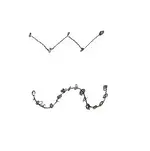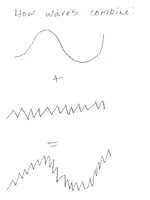ok, this is how it works, at least in my understanding,
PART A - sample rate
any individual "sample" contains one sampling of voltage. as in how much voltage. a waveform on a wire is represented by a varying voltage. so, any single sample contains the information for an amount of voltage.
by itself, one sample cannot represent a waveform. it takes more than one sample to make a waveform.
This is why it is said that the highest frequency that can be represented by a 44,100 sample rate is 22,050. in this scenario, each 22,050 hz waveform is represented by two samples: a peak and a trough.
If the freqency were 11,025, each waveform could be represented by 4 samples. and if it were 5512, it could be represented by 8 samples, which would give an even better estimate of what the waveform once was.
PART B - bit rate
the number of bits is relative to the detail of the voltage reading. this is confusing, because it is also the range of voltage reading.
each bit = 2 possibilities...
so 1 bit = 2 possible voltage samplings: 0 or 1
2 bits = 4 possible voltage samples: 00, 01, 10, 11
3 bits = 8 possible voltage samples: 000, 001, 010, 011, 100, 101, 110, 111
etc, etc.
so, it can be said that each bit "doubles" the amount of samples.
well, in decibels, each 6db "doubles" the volume. this is convenient, because each bit can now represent 6 db.
16 bits = 96 db range and 20 bits = 120 db.
here is the cool part (IMO).
TIMBRE
-------
why does an "A" note played on a piano sound different than an "A" note played on a guitar? Why does the "A" note on a les paul sound different than an "A" note on a strat?
the answer is the harmonic structure. The varying relative degrees of the harmonic structure is what determines the character of the instrument. Its a fact, look it up.
what this means is that if you have an A:440,
the detail of the quality of the note is going to be present in frequencies up to the range of human hearing and higher (as we know it has been proven).
This is why 44,100 was chosen as the "standard" bit rate. It is the range of human hearing x 2 (remember 2 samples needed to make a waveform).
PUT IT ALL TOGETHER
---------------------
more bits = more db right? well, this also translates to more detail. the detail of an instrument is in its harmonic structure and these harmonics are at generally a much lower volume than the fundamental notes. this is why capturing the low-level sounds are important. low volume material = more detail.
because its not only a smaller level you can read, but also a smaller change in sample values, giving you more detail. everything is in ratios... so if a very loud sample is 1 and a very quiet is 1/1000 but more bits could get you 1/10000 (even lower level), then that means you just gained all of the values between .9990 and .9999.......each bit is like adding a significant digit. you just get more and more detailed...
I'll try to post some diagrams.



